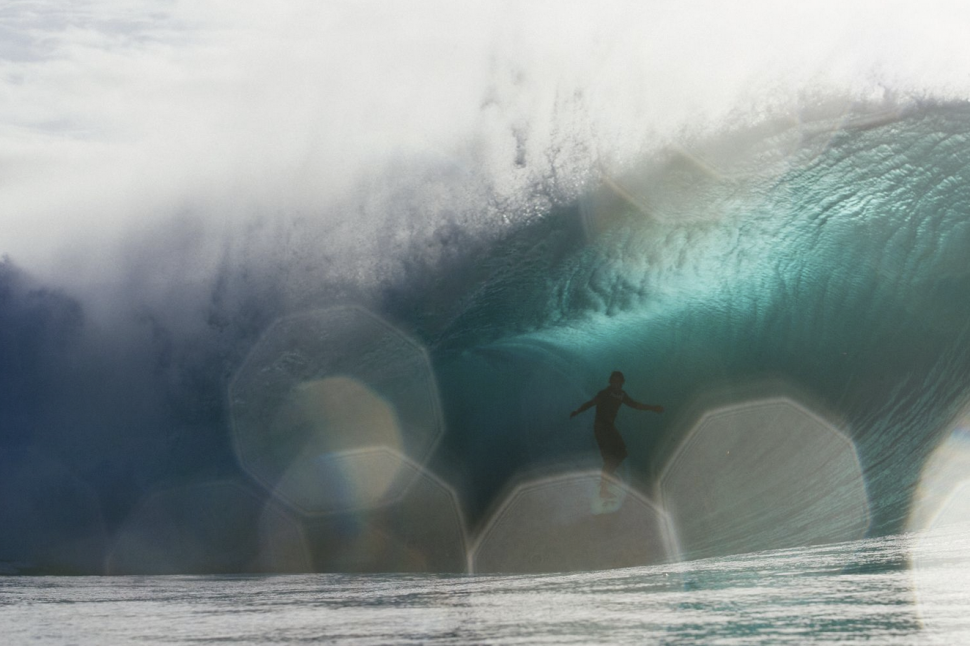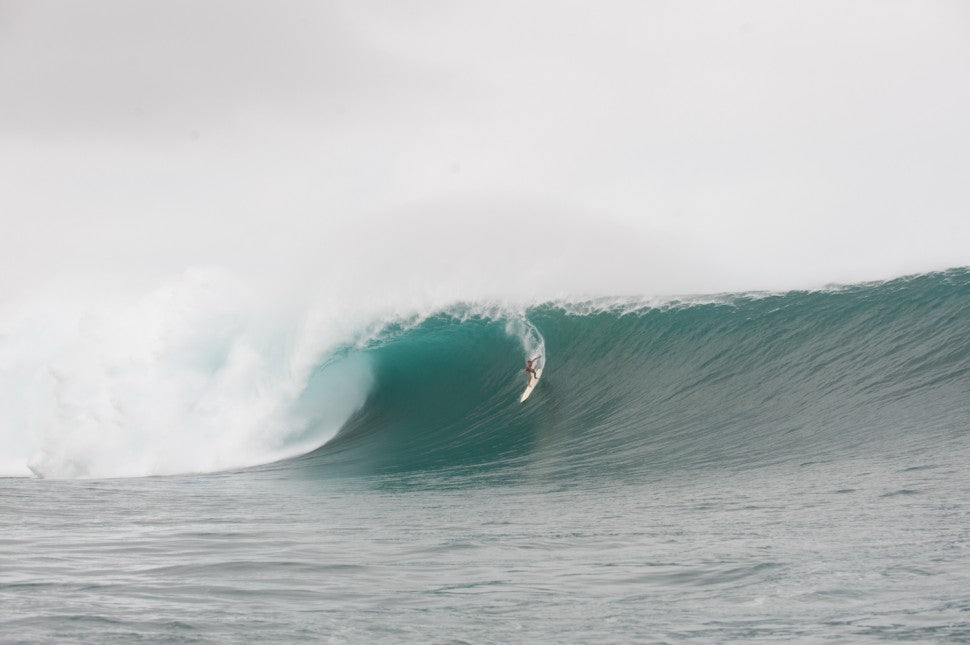Dodging Waves with Daniel Russo
If you've ever picked up a surfing magazine, it's likely you've noticed Daniel Russo's photography. His work spans an array of diverse brands and publications, citing Quiksilver promotions, and now more recently Vans campaigns, among them. Furthermore, he's the only photographer to have the cover of Surfer, Surfing, and Transworld all in one month -- perhaps a snap of Nathan Fletcher dropping into a bomb here, or Joel Tudor pulling deep into the tube there. But what often gets overlooked is the eye behind those shots; most don't realize the strategy, physical strength, and vulnerability that comes along with being a surf photographer.
Here, the man behind the lens shares stories of his near brushes with death, the physicality of surf photography, and photos of his travels.

[Mexico]
"I grew up on the North Shore. I was born in 1981, so I was like a '80s surf kid on the North Shore of Oahu."
"As I got older, I got an itch to shoot photography in the water, mainly just as a hobby. I was always in the ocean watching surf photographers, seeing what they did. I paid attention to them on the beach when they were about to swim out with their water houses and I was really curious about the whole thing."
"I started saving up some money. Back then, the equipment (as far as the water housing for the cameras), it was quite expensive for me, especially because I was working only part-time and going to school. It took me about two years to save up for everything. Fortunately, my childhood friends grew up to be pro surfers, so I had a lot of familiar faces around me when I was starting out."

[Empty Tahiti]

[Helicopter view, Hawaii]
"A lot of my photography, in the beginning, was bad. My friends who were pro surfers were saying how it would be rad if I could go shoot with them, but that I needed to get better. So I sped up my process -- they were excited and wanted to work with me. From there, it grew from a curious idea into a job, about five years after I got into it."
"I went on a trip to Mexico and I was using an older film camera, and the shutter was sticking and wasn't opening when I fired the trigger, so a lot of the shots came out black. I didn't know the shutter was having a malfunction the whole time I was down there. When I got the film developed all the roles were coming out black. Somehow the whole role was black except one photo, and it was this crazy water shot on a giant wave in Puerto Escondido, and that was the one that ended up getting published in a magazine. It was completely by accident. I sent it in to a couple of magazines to see if anyone would want to run the shot, and Surfing magazine was like 'Hey, do you want to work for us?' -- they ended up hiring me, that's kind of where it all started."

[Puerto Escondido]
"Back home in Hawaii, I flourished. Hawaii became my studio in a sense. It was my backyard, I felt really comfortable, and I know the ocean really well, so once my photography abilities caught up to my ocean knowledge, it became one. Surfing companies began to trust me and my work, and Quiksilver hired me to be a staff photographer, so I did that for a few years. Then I stopped working for them, and long story short, Nathan Fletcher introduced me to the amazing people at Vans. Thanks to him, I was able to build up a relationship with them, and now I've been working for Vans as a staff photographer for the last two and half years. "

[Birds in Tahiti]

[Daniel's home]

[Raimana Van Bastolaer, Tahiti]
Being a surf photographer, you're constantly putting yourself in the impact zone. You get the shot, and then you get hammered by a wave, and you can only hope you captured what you needed. It's very physical, more so than most other types of sports photography.
"I never really thought about what was going on or what could happen, or the dangers of it. I think where I grew up and how I grew up, I developed a comfortable feeling in dangerous situations. So going to parts of Mexico or Australia where there are shallow reefs or rip currents or sharks never really made me think twice. I think what kept my mind off of that type of stuff was the pure idea of travel, seeing crazy locations, and then the photography aspect was just like a bonus on the side."

[Tahiti]

[Underwater, Pipeline]
"There have definitely been times where I was thinking, 'How am I going to get myself out of this situation?' -- there was one recently in Tahiti this year. I was trying to get myself way inside of the boats and everything else that was going on. When it's really big, there's tons of boats. It becomes like a chess game of getting a photo with no foreground of boats and people. So I decided to swim on the inside of the boats. There's this fine line of where you can hang out in, where you're not too far in and you're not too far out, and if you stay there you're ok. But if you start going too far either way, you start to get yourself into a dangerous situation. I got myself there and I swam under the first wave, it was fine. Then I swam under the second one, I was fine. Then because I was fine, I got a little bit lazy and just swam under the third thinking 'I got this' and it was like somebody grabbed me by my ankles and whipped me back upside down. I got sucked over the falls and spun around like I was in a washing machine. For about 10 seconds this went on -- left, right, upside down. I started to feel scared because I knew how big it was and I knew what could happen, I've seen people get really hurt in that area. And when I came up, and I was way inside, and I saw another huge wave coming and I was thinking 'This is it. This is where I'm going to get really hurt.' So again I get slammed down, and somehow miraculously it shot me forward out of the impact zone. But that was a situation where I was scared. If you're not around those types of waves consistently, you kind of fall out of a pattern, out of rhythm. I hadn't been around those types of waves in a while."

[Andy Irons]

[Dane Gudauskas, Tahiti]

[John John Florence, Tahiti]

[Mark Healy]
"The only thing that I have to help me are my swim fins and those can easily get ripped off. Then you have a ten to sixteen pound camera that you're holding in your hands. The fins are pretty much your mobility, in terms of swimming around and getting yourself into position. There are jet skis zipping around, but they don't know where you are, they're not looking for you."
"I tend to bring a lot of cameras, whether it's film, digital, point and shoot, or medium format. I try to use all the cameras, I try not to shoot with only one type of camera. I try to stay open and not get so caught up in what everyone else is doing."
"I also tend to look to snow photographers and filmmakers. It gives me something fresh to look at. I love the scenic aspect of snow photography, with the mountains and valleys and the trees. Surf photography tends to get a little flat and one dimensional, there's only so much foreground you can add, or you can only look into the barrel so many times."

[Nathan Fletcher]
"Nathan Fletcher, myself, and Kohl Christensen were invited to go down to Chile through some local guys. Long story short, we decided on chasing swell a little bit north. We got up into this area that was somewhat uncharted, no one had really been up there. The waves were ginormous, and we ended up getting a fishing boat to take us out there because it was far out off the land on the back of the island. So it's them two, and myself, and this local Chilean boat driver with an outboard motor and motoring out together. And they surfed the first wave together, no one had ever surfed that wave before. The third wave Kohl got, it was this crazy huge wave and that ended up exploding on him and he got washed into these rocks and got all banged up. We were out in the middle of the ocean with no one around, we couldn't call anybody. He ended up being ok, only a few broken ribs. Those are the kind of trips I'm usually on -- adventures, wild times with Nathan. We're all friends, which is the rad thing."

[Joel Tudor, Pipeline]
"I did a trip with Joel Tudor and Nathan recently, we were in Indonesia and that was really rad. It was four days at this place called Desert Point, it was a perfect left, you could get up to a thirty second barrel on the right wave. With Joel, he's riding his style of boards, sharing waves, it's that style of riding. I was never really around Joel when he was younger, I've been trying to shoot with him more in the past four or five years, especially now I'm with Vans. His surfing is crazy -- you know a lot of times people tend to look at smaller wave surfing like it's not that hard. But it's crazy how the guy never falls. That's the nice thing about Joel and Nathan, they love to surf, whether it be one foot or fifty feet, perfect left point or a sand bar, they just love being in the ocean. That's what makes it fun photography-wise."
To see more of Daniel's work, go here.










[Mike Pietsch wipeout]